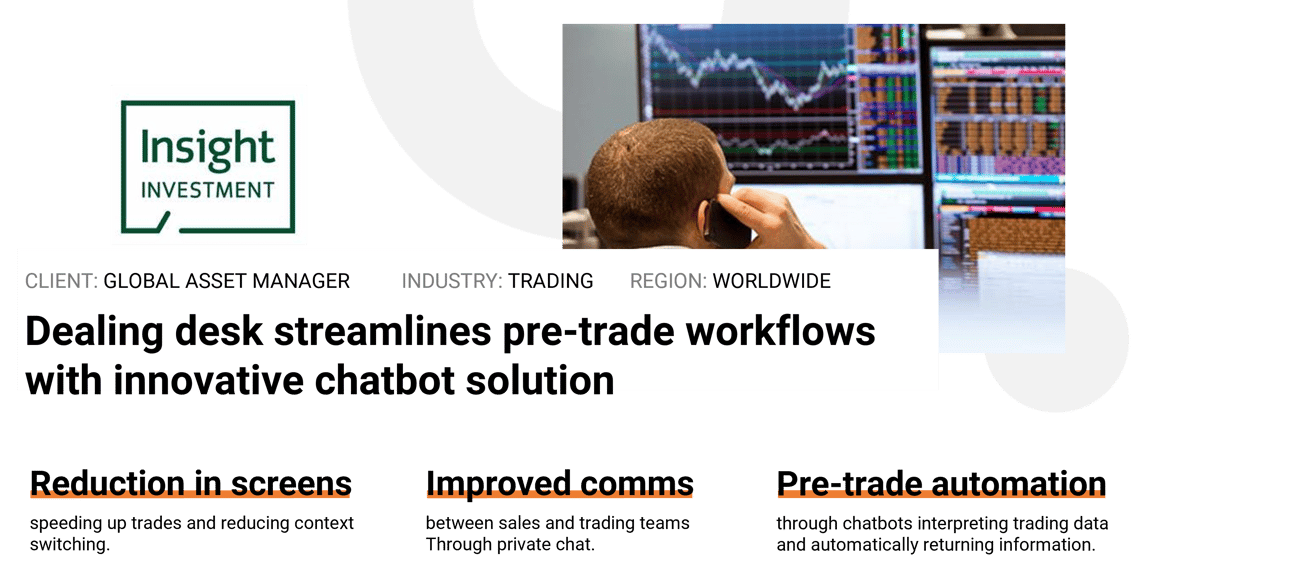
CLIENT OVERVIEW
Insight Investment, a Liability Driven Investment (LDI) dealing desk at a leading global asset manager with AUM across LDI, Multi Asset, Absolute Return and Fixed Income and Currencies. The trading desk trades cash and derivative products across Fixed Income, Equities, Credit and FX.
The Challenge
The trading desk trades complex packages of trades consisting of both cash and derivative instruments, which typically require a combination of digital and voice communication to complete transactions. At a practical level, this creates a need to monitor multiple chats at any time and combine that data with information received via other channels. The lack of a centralised record reduces the ability to work on several transactions at once or share work across the team, as each deal requires monitoring of a different set of communication channels. The existing process makes it difficult to gain live oversight across the desk activities and to record valuable data of the pre-trade negotiation workflow process accurately and efficiently.
In addition to the difficulties around collecting information from sell-side organisations in response to their enquiry, the trades are typically described using a mix of email and Microsoft Excel spreadsheets across multiple files and formats, which leads to a manual and often inefficient workflow at the sell side. On the sell side, trade data is typically manually extracted from the files to represent the trade in internal pricing systems before any decisions are taken around the pricing of risk and any other assessment of the trade value.
The number of manual touchpoints within the process and the lack of data connectivity between the buy and sell sides lead to an inefficient and costly process, with operational risk being a significant concern among all participants. Client service can suffer too, due to the unstructured nature of the workflow process.
The Solution
The client recognised that partnering with an organisation with expertise in data sharing and chatbot technology would be the best route to achieve uptake amongst sell-side counterparts and create the standardised framework the market is looking for. Whilst fast time-to-market was important, more significant was the ability to develop the product in line with user feedback and quickly scale across asset classes and product lines.
The Benefits
The approach had several advantages over previous ways of working. Firstly, it was vital that the approved solution would integrate into existing trading systems and needed to consolidate the number of screens traders worked on, as context switching between applications and screens was slowing down their ability to conduct trades and service clients more effectively.
The client is facilitating the negotiation between the buy and sell sides using chatbots deployed within existing chat rooms, using standard pre-trade syntax. It uses financial networks like Symphony to deliver the standardised syntax within private bilateral chats to allow trading and sales to communicate detailed information.
In addition, chatbots can interpret key data within messages, so instead of a human having to manually type back in a chat session, they can use an app – much like a trading screen – to respond, or, if they choose, the chatbot can connect direct to a pricing engine and auto respond.
Chatbots can interpret key data within those messages, display them within a custom application and allow the end user to streamline workflow from a single place. Data mapping transforms incoming and outgoing data into the required format, creating an extensible solution to interoperate between new and existing standards. The inclusion of structured data objects within messages, containing instrument definitions, event descriptions and a wealth of other metadata, can further aid automation of pre-trade workflow.
The future
Given the increased efficiency and productivity that has resulted from the deployment of ipushpull, the client is now considering the adoption of the service into other asset classes and options products where the standardised syntax and structured object capabilities can be most efficiently utilised. This highlights how product-agnostic the offering is as it operates around live data sharing rather than specific aspects of the product specifications. Moreover, other departments within the client are investigating use cases where they can also improve productivity and client interaction, for example, through the systematic distribution (push) of fund prices and information at given times of the day or permissioning certain clients to pull material data as and when required.

-1.png?width=2000&name=Untitled%20(45)-1.png)
.png?width=1200&height=628&name=Blog%20header-1%20(27).png)


